An initiative to “Give BIRDS the ROW” in terms of creating big habitats in highway rights-of-way is expanding across Illinois – with new support from the Illinois Department of Transportation.
[Above photo by the Illinois DOT]
The program originated with the installation of birdhouses for “prothonotary warblers” along the Lost Bridge Trail near Illinois DOT’s headquarters in Springfield, IL. The program’s goal is to restore diverse bird species on rights-of-way or ROWs under the control of Illinois DOT. In its latest effort, a group of Illinois DOT employees recently helped install bluebird houses, provided by the McHenry County Audubon Society, at the Coalfield Rest Areas on I-55 near Litchfield in Montgomery County.
Posted in short-grass, open-yard habitats, these birdhouses not only provide a resting spot for bluebirds but also attract other native bird species.
“In total, four bluebird houses have been posted so far: two at the northbound Coalfield Rest Area and two at the southbound Coalfield Rest Area,” said Jarod Hitchings, who works as a photogrammetrist for the agency, in a statement. [Editor’s note: “Photogrammetry” is the use of photography in surveying and mapping to measure distances between objects.]
“The installation of more houses are planned for prothonotary warblers along the Spoon River and for bluebird houses at rest areas and other appropriate short-grass, park-like habitats maintained by Illinois DOT,” he said.
Fellow Photogrammetrist Brenda Anderson joined Hitchings – who both work for the agency’s bureau of design and environment – to install those birdhouses. They received assistance from Illinois DOT District 6 Roadside Management Specialist Mike Staab and Junior Construction Inspection Technician Marcell Lare, Roadside Maintenance Manager Stephanie Dobbs, District 8 Acting Rest Area Manager Jacob Cuff, and District 5 Roadside Manager Scott Hall.
Illinois DOT Design and Environment’s Bicycle and Pedestrian/ADA Policy Engineer Steve Letsky also donated handcrafted birdhouses he built on his own for this effort.
“Operations and Design and Environment have worked well together to promote declining bird species,” Hitchings noted. “Partnering with the district offices, we have truly made this a statewide effort to promote a healthy environment for our feathered friends. Birds are a sentinel species and are a signal that the natural landscape is healthy for all wildlife.”
“We hope to grow this program and install a variety of houses at different locations as the habitat and range indicate,” Dobbs added. “In the future, if interesting species find homes on our right of way, we would like to do a webcam or something similar to share it with employees and the public.”
State departments of transportation across the country are involved in a number of efforts to protect and preserve bird species where possible.
For example, a mitigation program operated by the North Carolina Department of Transportation’s Division of Aviation aims to reduce the risk of wildlife hazards by providing a variety of training and support options for both airports and aircraft.
“Flocks of birds taking flight, deer crossing runways, and other such hazards can cause serious damage to property and even loss of life,” noted Rajendra Kondapalli, the program’s manager, in a statement. “Our program focuses on reducing that risk and increasing safety for aircraft that fly in and out of airports across our state.”
Meanwhile, the Minnesota Department of Transportation recently helped test ultrasonic bat “deterrence devices” at two bridges to help keep the mammals away from such structures when they undergo maintenance and/or repair activity.
The agency noted that bats like to roost in bridge expansion joints and temporarily preventing such roosting during bridge maintenance repair activity typically requires installing physical barriers that are often difficult to establish effectively, due to the design characteristics of many structures.
More importantly, the Minnesota DOT does not necessarily want to keep bats away permanently from its bridge as they provide safe roosting areas. Thus, the agency worked with the Minnesota Department of Natural Resources and the U.S. Fish and Wildlife Service for the last two years testing battery-operated ultrasonic deterrence devices that reduce bat activity at bridge sites when activated but ensure a quick return of bat roosting activity when deactivated.


